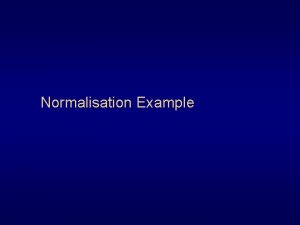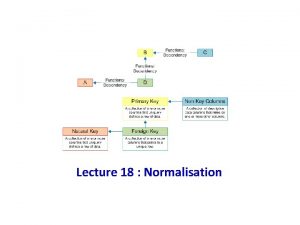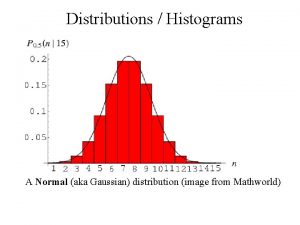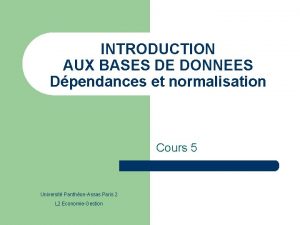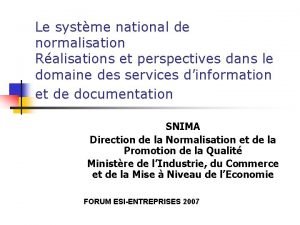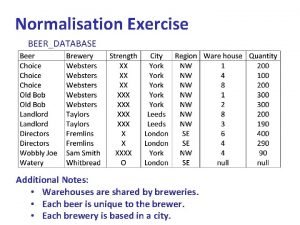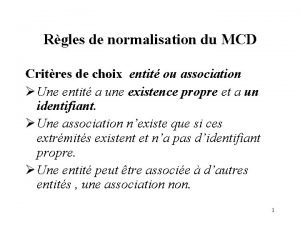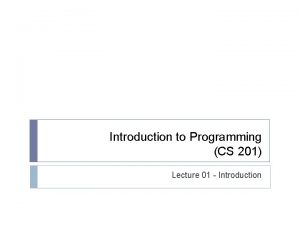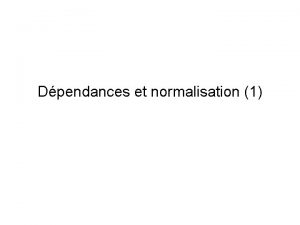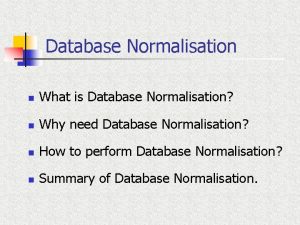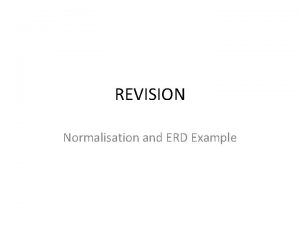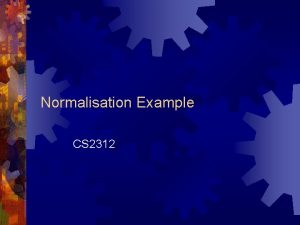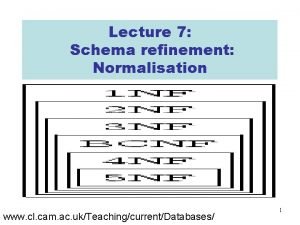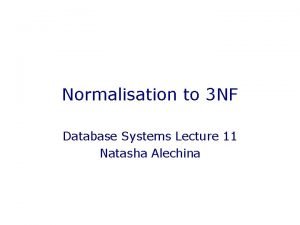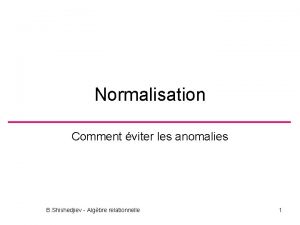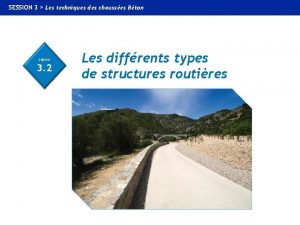Lecture 18 Normalisation Normalisation 1 What is Normalisation

























- Slides: 25

Lecture 18 : Normalisation

Normalisation (1) • What is Normalisation? Informally, normalisation can be thought of as a process defined within theory of relational database to break up larger relations into many small ones using a set of rules. Normalisation resolve problems with data anomalies and redundancy. It is essentially a two step process to: 1. put the data into tabular form (by removing repeating groups); and 2. to remove duplicated records to separate tables. As we work through the normalisation process, we will make use of data that relates to the Bus Depots’ Database – a description and E R model of which was handed out in last weeks session and is also available from the resource area. 2

Normalisation (2) • Un normalised data (1) Well normalised databases have a design that reflects the true dependencies between entities, allowing the data to be updated quickly with little risk of introducing inconsistencies. Before discussing how to design a well normalised database using Codd's normalisation techniques, we first consider a poor database design. Consider for example a relation 'bus' which includes bus registration number, model, type number, type description, depot name (note that names have changed slightly from the study for the purposes of this example): registration no model type number type description depot Al 23 ABC Routemaster 1 doubledecker Holloway D 678 FGH Volvo 8700 2 metrobus Holloway H 2591 JK Daf SB 220 3 midibus Hornsey P 200 IJK Mercedes 709 D 2 metrobus Hornsey P 300 RTY Mercedes Citaro 4 bendy bus Hornsey R 678 FDS Daf SB 220 1 doubledecker W 653 TJH Routemaster 1 doubledecker 3

Normalisation (3) • Un normalised data (2) There are several problems with the previous relation: – Redundancy the 'type description' is repeated for each 'type number' in the relation. The 'model' is also repeated for a particular 'type description', for example a Routemaster is always a doubledecker bus – Update anomalies as a consequence of the redundancy, we could update the 'type description' in one tuple, while leaving it fixed in another – Deletion anomalies if we should delete all the buses of a particular type, we might lose all the information about that type – Insertion anomalies the inverse to deletion anomalies is we cannot record a new type in our table unless there exists a bus of that type for example if there is the type 'open top' we cannot store this in our database. To get around this we might put null values in the type number and description components of a tuple for that bus, but when we enter an item for that supplier, will we remember to delete the tuple with nulls? 4

Normalisation (4) • Functional dependencies (1) Determinants A formal definition for the term functional dependence is: Given a relation which has attributes (x, y, . . . ), we say that an attribute y is functionally dependent on another attribute x, if (and only if) each x value has associated with it precisely one y value (at any one time). For example, examine the following relation: Cleaner no. (cno) Cleaner name (cname) Cleaner salary (csalary) Depot no. (dno) 110 John 2550 101 111 Jean 2500 101 112 Betty 2400 102 113 Vince 2800 102 114 Jay 3000 102 5

Normalisation (5) In the previous diagram, attributes cname, csalary and dno are each functionally dependent on attribute cno given a particular cno value, there exists precisely one corresponding value for each of the cname, csalary and dno. In general then, the same x values may appear in many different tuples of the relation; if y is functionally dependent on x, then every one of these tuples must contain the same y value. Going back to the cleaner example, we can represent these functional dependencies diagrammatically as: 6

Normalisation (6) The previous figure is an example of a determinacy diagram. The arrow line can be read as 'depends on' (reading from left to right). So we say, for example, 'cno depends on cname'. We can also 'read' the diagram from right to left. This time the arrowed line is read as 'functionally dependent on'. So we say, for example 'cname is functionally dependent on cno'. The attribute or group of attributes on the left hand side are called the determinant. The determinant of a value is not necessarily the primary key. In the example, cno is a determinant of cname because knowing the cleaner's number we can determine the cleaner's name. Recognising the functional dependencies is an essential part of understanding the meaning or semantics of the data. The fact that cname, csalary and dno are functionally dependent on cno means that each cleaner has one name, has one salary and works at precisely one depot. 7

Normalisation (7) • Functional dependencies (2) Composite attributes The notion of functional dependence can be extended to cover the case where the determinant (particularly the primary key) is composite, i. e. it consists of more that one attribute. Full functional dependence An attribute y is defined to be fully functionally dependent on attribute x if it is functionally dependent on x and not functionally dependent on any subset of the attributes of x where it is a composite attribute. Partial dependencies The opposite of full functional dependence is partial dependence. Where we have data values that depend on only a part of the primary key, then we have a partial dependency. Transitive dependencies This occurs when the value of an attribute is not determined directly from the primary key, but through the value of another attribute and this 8 attribute in turn is determined by the primary key.

Normalisation (8) • The normal forms A number of normal forms have been proposed, but the first five normal forms have been widely accepted. The normal forms progress from first normal form, to second, and so on. Data in second normal form implies that it is also in first normal form i. e. each level of normalisation implies that the previous level has been met. Other normal forms such as Boyce Codd (BCNF) which is an extension of 3 NF, 9

Normalisation (9) Correspondence between the normal forms: 10

Normalisation (10) • Normal form example Consider the following example forms that record information about cleaners at the Middlesex Depot and the buses they look after. Note that three extra attributes, roster number, roster date and job complete have been added to the original model. The cleaner ticks against the appropriate job after he/she has completed the cleaning of a particular bus. 11

Normalisation (11) The un normalised relation: 12

Normalisation (12) • First normal form (1 NF) The next step in the normalisation process is to remove the repeating groups from the un normalisedrelation. A relation is in 1 NF if and only if all domains contain only atomic or single values, i. e. all repeating groups of data are removed. A repeating group is a group of attributes that occurs a number of times for each record in the relation. So for example, in the Roster relation, each roster record has a group of buses (roster record 104 has 6 buses). Selecting a suitable key for the table In order to convert an un normalised relation into first normal form, we must identify the key attribute(s) involved. From the un normalised relation we can see that each roster has a roster no, each cleaner a cno, each depot a dno, each bus a reg no and each type a tno. In order to convert an un normalised relation into normal form, we also have to identify a key for the whole relation. Bearing this definition in mind, on examination the primary key of the relation is roster no, reg no. We now draw the determinacy diagram for the roster relation, showing 13 the attributes which are dependent on the primary key:

Normalisation (13) Determinacy diagram for the first normal form: 14

Normalisation (14) Roster relation in first normal form: 15

Normalisation (15) • The problems with 1 NF are: – Redundancy e. g. roster date, cleaner name etc repeated – Insertion anomaly a cleaner cannot be inserted into the database unless he/she has a bus to clean – Deletion anomaly deleting a tuple might lose information from the database. For example, if a cleaner cleaning a particular bus leaves the company, then we lose information for the buses he cleaned – Update anomaly e. g. a change to the cleaner name means it must change in all tuples which include that cleaner name. 16

Normalisation (16) • Second normal form (2 NF) We now describe the second step in the normalisation process using the relation above which is in first normal form. Firstly we determine the functional dependencies on the identifying attributes (i. e. the primary key (roster_no, reg_no) and its parts. If the key is composite, the other attributes must be functionally dependent on the whole of the key. In other words we are looking for partial functional dependencies. In the example, roster date is functionally dependent on the partial key roster_no there is only one roster_date for a particular roster_no. Also cno, cname, dno, dname etc are all functionally dependent on the partial key reg_no. The attribute 'status', however, is the only attribute fully functionally dependent on the whole of the primary key. 17

Normalisation (17) Determinacy diagram for the second normal form: 18

Normalisation (18) Roster in first second normal form: 19

Normalisation (19) 2 NF has less redundancy than 1 NF as we have removed repeating groups. However there are still a number of problems: – Redundancy for example, in the Bus relation, cleaner name is repeated for each cleaner number – Insertion anomaly a cleaner cannot be inserted into the database unless he/she is responsible for at least one bus – Deletion anomaly deleting a tuple might lose information from the database. For example, if we delete a cleaner who is only responsible for that one bus, then we lose information about the cleaner – Update anomaly e. g. a change to the cleaner name means changes must be made in all tuples which include that cleaner name. 20

Normalisation (20) • Third normal form (3 NF) A 3 NF relation is in 2 NF but also it must satisfy the non transitive dependency rule, which states that every non key attribute must be non transitively dependent on the primary key. Another way of saying this is that a relation is in 3 NF if all its non key attributes are directly dependent on the primary key. Transitive dependencies are resolved by creating new relations for each entity. There are three transitive dependencies in the Bus relation above as is illustrated by vertical lines in the 2 NF determinacy diagram. For example: cno is functionally dependent on reg_no; cname is functionally dependent on reg no. Additionally, cname is functionally dependent cno. We therefore have the transitive dependency: reg no determines cno and cno determines cname then reg_no determines cname Two other transitive dependencies are identified involving tname and dname. The determinacy diagrams for third normal form are given below: 21

Normalisation (21) Determinacy diagram for the third normal form: 22

Normalisation (22) Roster in first third normal form: 23

Normalisation (23) Normal form What is it? What does process do? How is it achieved? 1 NF Relation in 1 NF if it contains scalar (atomic) values only Removes repeating groups Make a separate relation for each group of related attributes Give each new relation a primary key 2 NF Relation in 2 NF if in I NF all non key attributes are dependent on the whole of the primary key and not part of it Removes redundant data If an attribute depends on only part of a multi value key, remove it to a separate table 3 NF Relation in 3 NF if in 2 NF non key attributes are dependent on primary key and independent of each other i. e. non key attribute must be non transitively dependent on the primary key a non key attribute is changed, that change should not affect the others Removes attributes not dependent on the key thereby further reducing redundancy Make a separate relation for attributes transitively dependent on the primary key Give each new relation a primary key Original relation will include a foreign key to link to new relation 24

Bibliography / Readings / Home based activities Bibliography An Introduction to Database Systems (8 th ed. ), C J Date, Addison Wesley 2004 Database Management Systems, P Ward & G Defoulas, Thomson 2006 Database Systems Concepts (4 th ed. ), A Silberschatz, H F Korth & S Sudarshan, Mc. Graw Hill 2002 Readings Introduction to SQL’ Mc. Graw Hill/Osbourne (handout) Home based activities Ensure you download xampp and install on home PC or laptop (if you have a slow home internet connection – download to data key or CD here at UWE) Copy the SQL Workbook onto your data key or CD. Import the tables from the SQL Workbook into your home My. SQL DB. Begin working through some of the query examples in the workbook using PHPMy. Admin. 25
 01:640:244 lecture notes - lecture 15: plat, idah, farad
01:640:244 lecture notes - lecture 15: plat, idah, farad Organisation internationale de normalisation
Organisation internationale de normalisation Normalisation
Normalisation Www.iso.org
Www.iso.org Fixed point notation
Fixed point notation Functional determinacy diagram
Functional determinacy diagram Normalisation
Normalisation Risk normalization
Risk normalization Normalisation
Normalisation Introduction sur la normalisation
Introduction sur la normalisation Système de normalisation
Système de normalisation Normalisation
Normalisation Organisation internationale de normalisation
Organisation internationale de normalisation Mcd location de voiture
Mcd location de voiture Data visualization lecture
Data visualization lecture Utilities and energy lecture
Utilities and energy lecture Les situation de passage de le dernier jour d'un condamné
Les situation de passage de le dernier jour d'un condamné Advanced operating system notes
Advanced operating system notes Parallel and distributed computing lecture notes
Parallel and distributed computing lecture notes Cs201 ppt slides
Cs201 ppt slides Comparative education definition
Comparative education definition Bipolar junction transistor lecture notes
Bipolar junction transistor lecture notes Othello lecture
Othello lecture Lecture vegetable
Lecture vegetable Lecture outline example
Lecture outline example Philosopher giving a lecture on the orrery
Philosopher giving a lecture on the orrery


